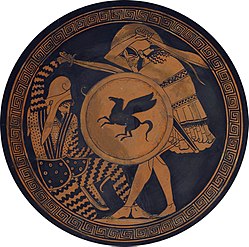Greco-Persian War
| Greco-Persian Wars | |||||||||
|---|---|---|---|---|---|---|---|---|---|
 Persian soldier (left) and Greek hoplite (right) depicted fighting, on an ancient kylix, 5th century BC |
|||||||||
|
|||||||||
| Belligerents | |||||||||
|
Other Greek states and Leagues:
|
Achaemenid Empire of Persia
|
||||||||
| Commanders and leaders | |||||||||
|
Miltiades Leonidas I † Pausanias Cimon † Pericles Onesilus † |
Artaphernes Datis Artaphernes (son of Artaphernes) Xerxes I Mardonius † Hydarnes Artabazus Megabyzus Artemisia I of Caria |
||||||||
Other Greek states and Leagues:
Achaemenid Empire of Persia
Allied subordinate states:
The Greco-Persian Wars (also often called the Persian Wars) were a series of conflicts between the Achaemenid Empire of Persia and Greek city-states that started in 499 BC and lasted until 449 BC. The collision between the fractious political world of the Greeks and the enormous empire of the Persians began when Cyrus the Great conquered the Greek-inhabited region of Ionia in 547 BC. Struggling to rule the independent-minded cities of Ionia, the Persians appointed tyrants to rule each of them. This would prove to be the source of much trouble for the Greeks and Persians alike.
In 499 BC, the tyrant of Miletus, Aristagoras, embarked on an expedition to conquer the island of Naxos, with Persian support; however, the expedition was a debacle and, pre-empting his dismissal, Aristagoras incited all of Hellenic Asia Minor into rebellion against the Persians. This was the beginning of the Ionian Revolt, which would last until 493 BC, progressively drawing more regions of Asia Minor into the conflict. Aristagoras secured military support from Athens and Eretria, and in 498 BC these forces helped to capture and burn the Persian regional capital of Sardis. The Persian king Darius the Great vowed to have revenge on Athens and Eretria for this act. The revolt continued, with the two sides effectively stalemated throughout 497–495 BC. In 494 BC, the Persians regrouped, and attacked the epicentre of the revolt in Miletus. At the Battle of Lade, the Ionians suffered a decisive defeat, and the rebellion collapsed, with the final members being stamped out the following year.
...
Wikipedia
